Ceremonies in 1948
Important guests
The Canadian War Cemetery aroused mounting interest. First of all there were the many casual visitors. On their way to the sea they considered the imposing cemetery worth a visit and wrote their name in the Cemetery Register.
7 May 1948: General Foulkes

On 7 May 1948 General Foulkes, chief of the
general staff of the Canadian Army
came to visit his fallen compatriots.
The general greets the central cross of sacrifice;
behind him we see master
Germain Boes, Herman Van Damme, the village priest and
burgomaster De Prest.
A good many important Canadian military officers also honored the cemetery with a visit. On 7 May 1948 Lieutenant-General Foulkes was the first one of them. Charles Foulkes was chief of the general staff of the Canadian Army and former commandant of the Second Canadian Army Corps, that took part in the liberation of Belgium in 1944. The general was accompanied by his wife and a few senior officers. After their visit to the cemetery the men were as usual received in the town hall by the burgomaster Mr. Jozef de Prest and the town councillors. They signed the commemorative book, "followed by a reception that you kindly offered to the chief of the General Staff of the Canadian Army and some officers who accompanied him on this occasion" ("suivi d'une réception que vous avez eu l'amabilité de bien vouloir offrir au Chef d'Etat-Major de l'Armée Canadienne et à quelques officiers qui l'accompagneront à cette occasion").
The general appeared very impressed with his visit and asked the burgomaster to thank all inhabitants of Adegem for the fact they hadn't forgotten their liberators.
On Sunday 12 September 1948, the anniversary of the liberation of Adegem, the town received the visit of major-general H.W. Foster. He had been invited by the city of Bruges to attend the commemoration ceremonies and he had come over from Canada specially for this. And of course the general wanted to honor the Canadian Cemetery in Adegem with a visit as a posthumous homage to his fallen compatriots. The very important guest together with the Minister of Transport Achiel Van Acker and his wife was welcomed by the Adegem town council and later on received in the town hall where the Golden Book was signed.
15 September 1948 : General Crerar

After his visit the famous general Crerar was received in the Adegem town
hall.
To thank the burgomaster for his hospitality he gave him this photograph with the dedication:
"To the Burgemeester of Adegem".
Finally on Wednesday 15 September the Adegem town council received the most famous general of them all namely Henry D.G. Crerar, CH, CB, DSO, ADC, former chief of staff of the Canadian Army. In 1944-1945 Crerar was the commander in chief of the Canadian forces in Europe. In 1948 he was charged by the Canadian government with an inspection visit to all the Canadian cemeteries in the Netherlands and in Belgium. He visited the cemetery in the company of his wife Veire. Marlowe Kennedy, attaché of the Canadian Embassy in Brussels, G. Greenwill of the Imperial War Graves Commission, H. Tellier, Crerar's aide-de-camp, and a few other military officers subjected the cemetery to a fairly thorough inspection and eventually had nothing but praise for the care taken in the layout and maintenance. As usual a reception awaited the important guests in the town hall and burgomaster De Prest paid homage and thanked the august representative of the Canadian people.

On Wednesday 15 September 1948 general H.D.G. Crerar came to the Adegem War
Cemetery for a visit of inspection. He was welcomed on his arrival by
burgomaster Jozef de Prest. Also in the picture: town secretary Prosper
De Smet, Mrs Veire Crerar, aide-de-camp Tellier and Marlow Kennedy, military
attaché to the Canadian Embassy.
During this private reception in the town hall burgomaster De Prest spoke as follows to the important guest:
"General,
In the month of September '44 we had the great pleasure to be able to applaud
and to flower the first Canadian tanks that came from overseas to liberate our
regions from a pitiless oppressor. Today we have the great honor to be
allowed to salute a Canadian general here on the field of honor in the midst of his fallen
soldiers. Four years have passed since the liberation
but the memory of those glorious feats of arms that marked that event remain
alive in the hearts of our compatriots. With pious veneration we flower
the tombs of these brave Canadian soldiers and we pray God he may rest their
souls. General, I speak for all the inhabitants of Adegem when I salute in
you the valiant Canadian Army and I extend to you our warm sympathy and all
our gratitude."

In the company of Marlowe Kennedy the general goes to the place where the
Cemetery Register is kept in order to sign it. Behind the general we
also see: curate Albert Heynkens, town councillor Albert De Kesel, secretary
Prosper de Smet, burgomaster Jozef De Prest, Mrs. Veire Crerar and
aide-de-camp Tellier.
Let's have a closer look at the military role General Crerar played in the liberation of the Breskens pocket. On 12 and 13 September 1944 field marshal Montgomery gave Crerar the order to liberate with the Canadian First Army not only the French ports of Le Havre, Boulogne, Calais and Dunkerke, but also to free as soon as possible the Scheldt mouth. Crerar didn't realize then that especially this last order far exceeded the power of his forces.
After the liberation of Ghent the Polish Panzer Division and the Fourth Canadian Panzer Division pushed through to Terneuzen almost effortlessly where the port fell into the hands of the Poles on 20 September. On the Western side of the Ghent-Terneuzen Canal things didn't go quite so smoothly. Crerar and his staff badly miscalculated the resistance of the enemy. Also according to experts he made the strategic error of attempting to cross the Leopold Canal near Moerkerke rather than near Maldegem or St.-Laureins where the Leopold Canal is further away from the Schipdonk Canal. Of course with hindsight it is always easy to say how it should have been done, but back there he HAD to act fast. Crerar had already shown on other occasions that he was capable of this. And we add to further exonerate the general that during the Zeeland-Flanders operations he had health problems.
Sunday 20 June 1948, Belgium-Canada Day
The Belgium-Canada Association had learned a lot from the two previous ceremonies and now they drastically changed the proceedings. Unlike the previous years the president welcomed the VIPs at the entrance of the St. Adrianus Church where now the commemoration ceremony was to take place. It was hoped that the people of Adegem would turn up in great numbers. "If only the weather might also be nice this would then be a unique day of homage and thanks from the whole Meetjesland for its liberators, " we read in "The Eecloonaer". And the weather was fine: a smiling sun made everything even more colourful.
"A fever of the grand days animated the charming village that relived again with the same ardor the glorious and tragic days of the Liberation of which its imposing cemetery is the symbol and the reliquary". Thus wrote Alice Sauton, who reported at length on the ceremony in the "La Flandre Libérale" newspaper. "The lovely church of the town was a blaze of candle light. In front there stood the great catafalque decked with the Canadian, British and Polish colours and surrounded by an honor guard of 4 soldiers in impeccable parade uniforms. In the choir we saw the flags of the dozens of participating associations and groups. On the right there was the boys choir of the Brothers of Charity, all dressed in white and for the very first time the Gregorius Choir—all 125 of them—could perform unperturbed the three-part Mass of De Boeck. The "Pie Jesu" and "Libera Me" but above all "O Canada" gave many the shivers, especially the Canadians present.
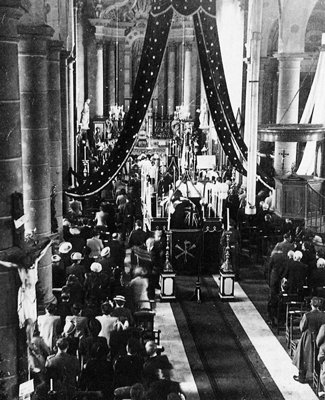
As always much care and attention had been spent on the solemn church
service. Under the enormous canopy that was only used for the most
ceremonious occasions we see the catafalque with on it the Union Jack and the
Belgian tricolor and surrounded by a guard of honor of four soldiers.
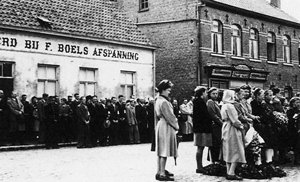
During the solemn service in the Saint-Adrianus Church of Adegem those who
took part in the march and all other interested persons attended an open air
Mass in
the town center.
The veterans, the deportees etc came together at the
inn called "Het Damberd" with among them constable Richard
Spillebeen. The pupils of the girls' school, stood in front of the altar
with the flowers and wreathes they would put on the graves of the Canadians
and with Amanda Lievens to keep an eye on them.
The prefect of Saint Barbara College of Ghent, the Reverend Van Causbroeck, in his sermon exposed the significance of the sacrifice of so many young men: "Happy are those who died for a just war. But may their holocaust not be granted in vain! Let's always remain true and faithful to those who have become our clay. Let's be united for real peace un mutual love and common hope! That will be the recompense of those who when they left have given us everything and also of those who have lost everything and who remain behind: the mothers, the widows and the orphans..."
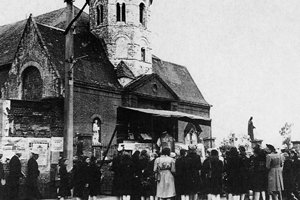
Friar Goethals, chaplain of the Resistance, celebrates a Mass in the town
center.
Over on the left there is a poster announcing this Canada Day.
During the celebration of the Eucharist in the church a Mass was said in the town center in front of the cemetery wall by friar Goethals, chaplain of the Resistance.
Burgomaster De Prest, proudly wearing the tricolor around his waist, very warmly received the numerous VIPs in the town hall where a "vin d'honneur" was served and the commemoration book was signed. With a touch of poignancy the burgomaster put into words the reason for this day. Mrs. le Clément de Saint-Marcq, the soul of these commemorations, was there with them in Adegem for the last time...
In the meantime a long parade was formed in town and the floral tributes in the cemetery were as always very impressive. Mrs. le Clément de Saint-Marcq spoke about the unwavering recognition that binds us to our liberators ("la reconnaissance indéfectible qui nous attache à nos libérateurs"). A child knelt in front of each grave to lay there a laurel wreath.
Ondertussen vormde zich een zeer lange stoet in het dorp en de bloemenhulde op het kerkhof was zoals steeds zeer indrukwekkend. Mevrouw le Clément sprak er over la reconnaissance indéfectible qui nous attache à nos libérateurs. Voor elk graf knielde een kind om een laurierkroontje neer te leggen.
After the ceremony Mrs. le Clément de Saint-Marcq and her party were received in the Villa des Acacias of Herman De Clercq in Eeklo. A reception was laid on for them, "intimate yet numerous, simple and somptuous, in exquisite surroundings, graciously lent by the most generous of housewives, who herself was also devoted to the most noble of causes" ("intime et cependant nombreuse, simple et somptueuse, dans un cadre exquis, gracieusement prêté par la plus généreuse des maîtresses de maison dévouée elle aussi à la plus noble des causes").
"It is a pleasure to express to you our sincere thanks for the support and assistance from the Burgomaster and the Town Council of Adegem for the organisation of the Belgium-Canada Day of 20 June", wrote Mrs. le Clément in her letter of thanks of 22 June 1948 to the Adegem town council.
As godmother of the French-Canadian Régiment de la Chaudière and as president of the association called 'Commemoration of Allied Graves' Mrs le Clément invited the Adegem council on 7 November 1948 to the annual solemn commemoration in the Saint Bavo Cathedral in Ghent to remember the allied soldiers who fell during the fighting around Ghent to liberate the city.
At the bottom of the invitation card we read that the consacration of the graves would take place on 2 November at 15 hrs. in the Canadian Cemetery at Adegem, meeting at the church. Would the consecration of the graves have to wait till then or did they mean consecration of the graves of the fallen soldiers of the Régiment de la Chaudière?
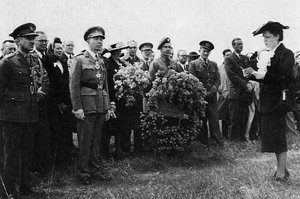
As president of the Belgium-Canada Association and of the Ghent Welfare, Mrs. le Clément de Saint-Marcq
addressed the guests. We see colonel De Clerck, standing in for the
Minister of Defense with behind him Miss Maria De Keyser. The biggest
wreath came from Ambassador Victor Doré who could not be there in person.
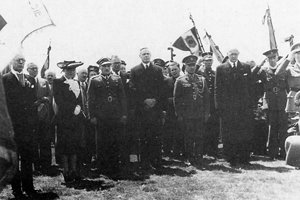
The dignitaries during the national anthem: Mrs.
le Clément de Saint-Marcq, captain Letzinsky, delegate of the Republic of
Poland, Lord W.H. Montagu Pollock, Mr. Jozef de Prest, burgomaster, major Ivaiser
of the Imperial War Graves Commission and Mr. Paul Migeon.